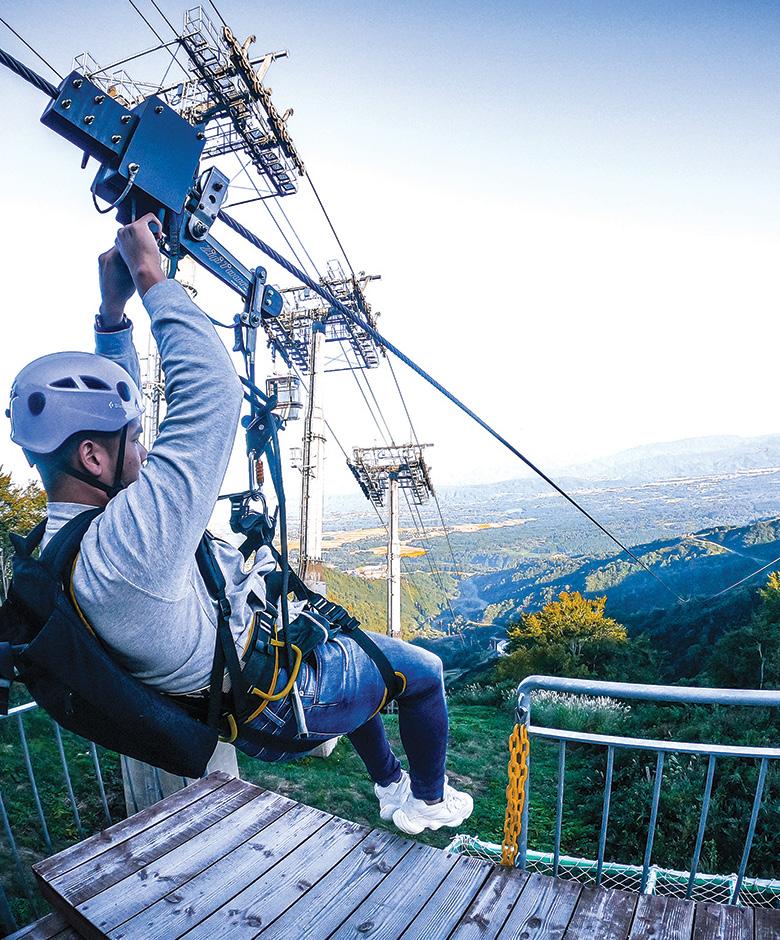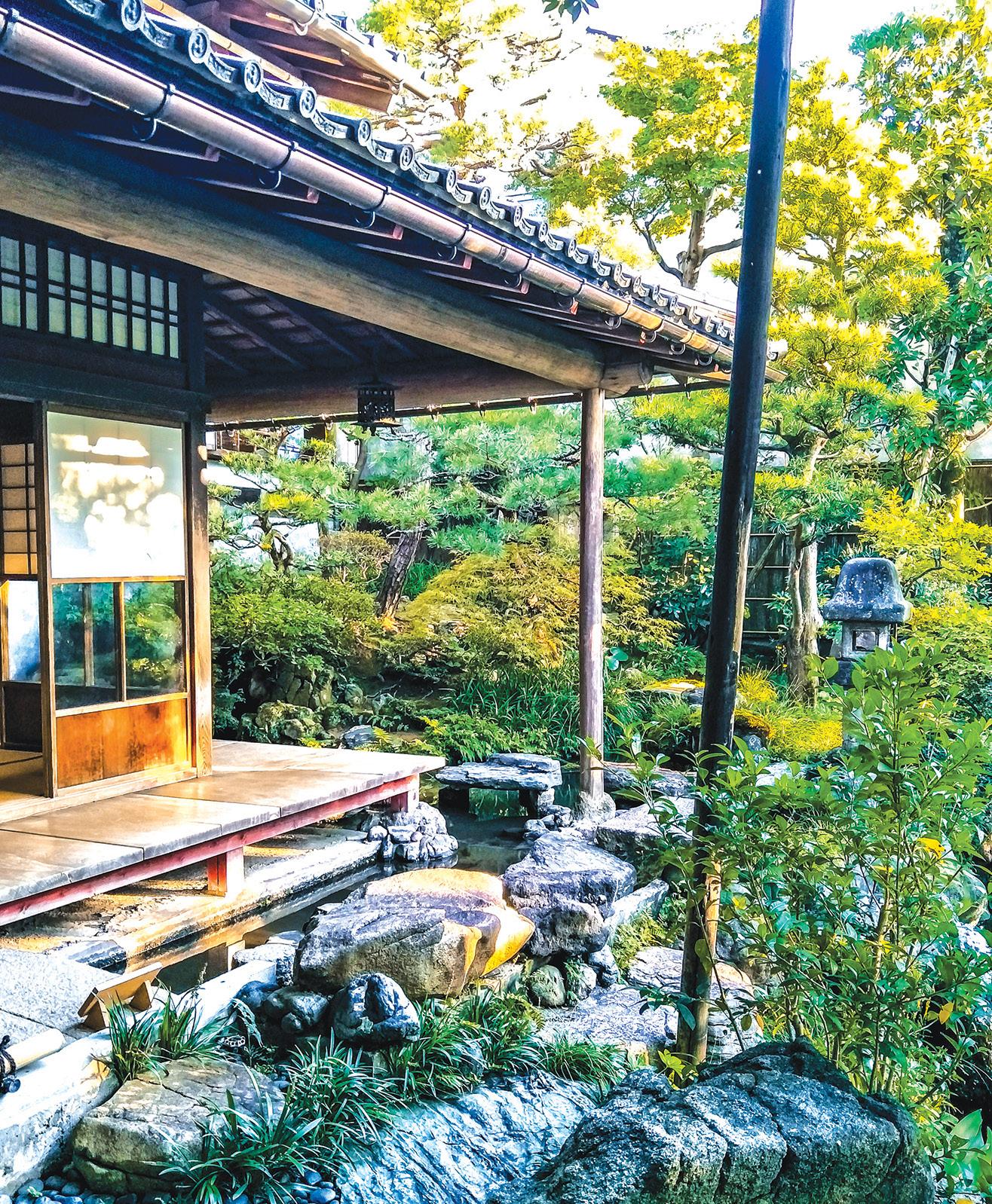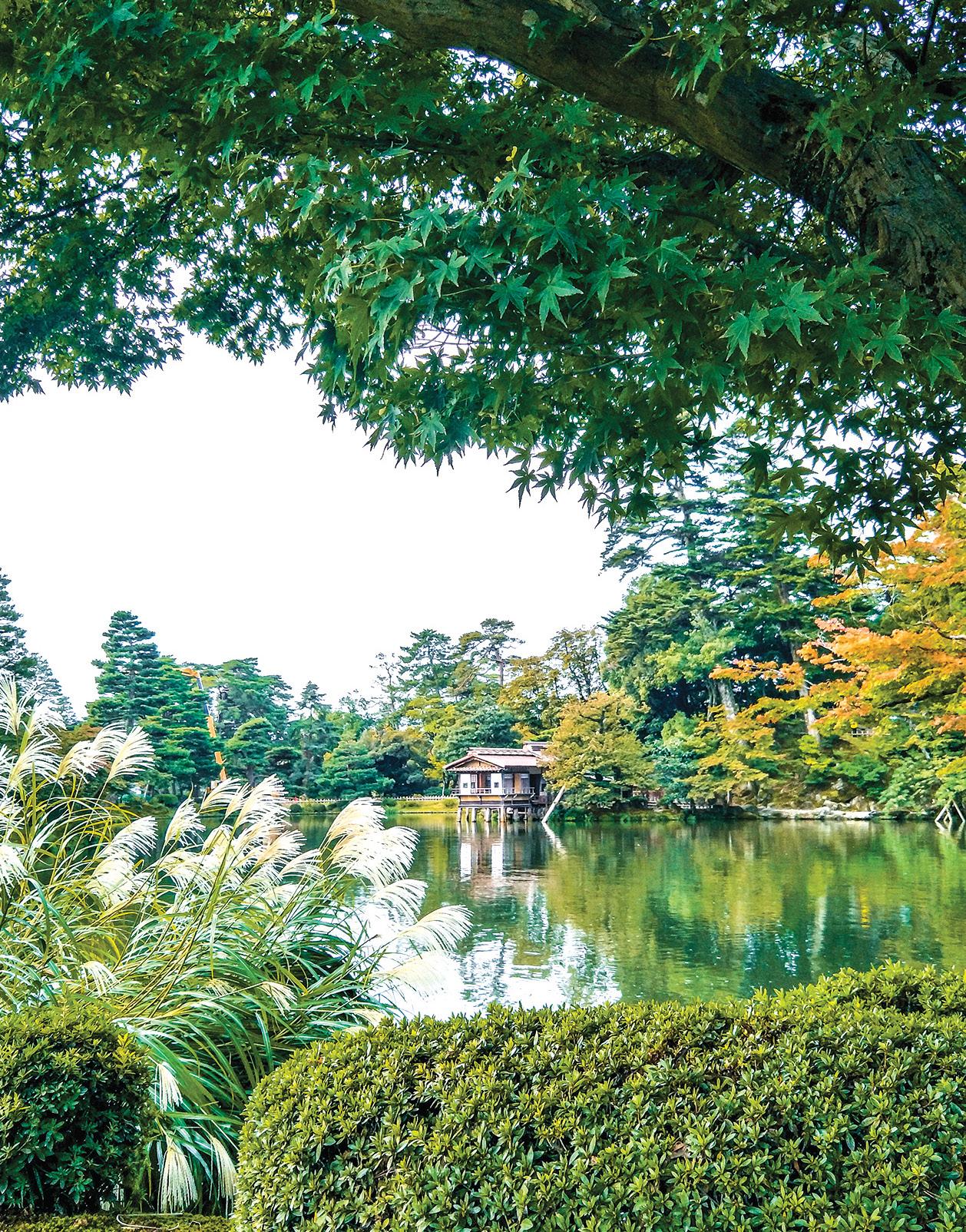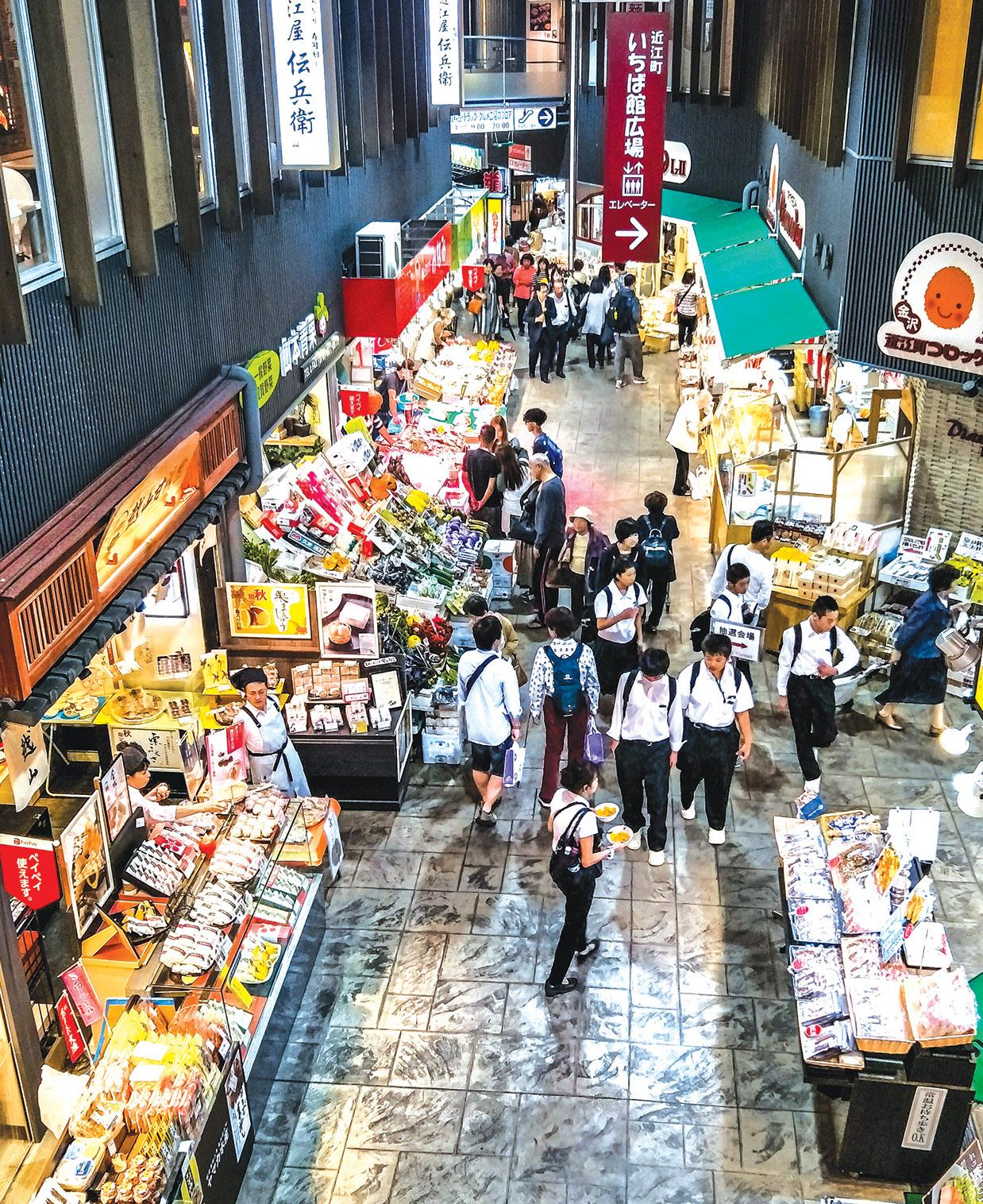
14 minute read
Destinations: Japan
Maxing Out the New Golden Route with Hokuriku Arch Pass
Text & Images by MUHAMMAD HASIF MOHD JELANI
They say that Tokyo represents Japan’s epitome of an ultimately-advanced urbanisation and Osaka is Japan’s food capital – both metropolises shape how we view Japan. So why not experience both while you are already on Japan’s Honshu island? Or even better, how about experiencing more of Japan by discovering the lessexplored destinations between the two destinations, which would leave you more enriched and fulfilled?
There a few options on how to get from Tokyo to Osaka by land. The more popular one that connects Tokyo and Osaka is called the Golden Route, where travellers can expect to see the conventional side of Japan along the way. But there is another alternative that can bring travellers to a different, more rural, less-crowded side of Japan, which is aptly named the New Golden Route, taking travellers along the coast overlooking the Sea of Japan. The route is best discovered using the Hokuriku Arch Pass that gives travellers access to commute from one place to another conveniently by train.
Follow me as I discover some of the marvellous spots along the New Golden Route…
Important points regarding Hokuriku Arch Pass:
» A seven-day pass costs ¥24,440 (around MYR945) if purchased outside Japan or ¥25,460 (around MY980) if purchased within Japan.
» It can only be used consecutively.
» It can only be used by non-Japanese travellers under ‘temporary visitor’ entry status.
» The pass offers unlimited travel on reserved and non-reserved seats in ordinary cars on the Hokuriku Shinkansen (between Tokyo and Kanazawa), Limited Express and local trains operated by JR-EAST and JR-WEST, Tokyo Monorail, and on Noto Railway between Nanao and Wakuraonsen within the area stated in the passholder.
» Seat reservations can be made in advance without charges at JR ticket office or Travel Service Centre in a JR-EAST or JR-WEST station. For non-reserved seat, travellers can simply show the pass. However, not all trains have non- reserved seats, therefore you may need to find yourself a vacant seat on the train.
» Please browse http://hokuriku-arch-pass.com/en to understand more about this pass.
TOKYO
TOKYO SKYTREE® (http://www.tokyo-skytree.jp/en/)
This 634-metre tall broadcasting tower is a must-visit in Tokyo mainly because it is the tallest tower in Japan and the tallest extant tower in the world! It also comes with two observation decks, one at the 350 th metre that has café, and another one at the 450 th metre that is uniquely designed with spiralling corridor. This tower is part of TOKYO SKYTREE TOWN SM , where travellers can conveniently visit two other attractions located at its base: TOKYO Solamachi, a shopping and entertainment complex; and Sumida Aquarium, which has the largest open indoor tank in Japan.
Sensoji Temple (http://www.sensojitemple.com/)
Paying homage to the Goddess of Mercy, Kannon, Sensoji Temple is the oldest temple in Tokyo. The temple was severely damaged during World War II but was rebuilt out of donations from Japanese people, making it a symbol of rebirth and peace. The temple is also iconic due to its Kaminarimon Gate that has become the emblem of Asakusa.
Ameyoko (http://www.ameyoko.net/)
This market street, which lies along Ueno to Okachimachi Station, was once used as a black market area where American products were largely sold. Today, the marketplace comes alive selling products ranging from clothes, cosmetics, dried and fresh foods at affordable prices. I also came across a few halal fast food eateries mainly serving variety of kebabs here.
Hotel Tavinos Hamamatsucho (https://hoteltavinos.com/en/hamamatsucho/)
Strategically located in Hamamatsucho, this trendy hotel with manga-inspired design is just 20 minutes by car from Haneda International Airport (HND). It is also close to public transport hub, providing easy access to major attractions across Tokyo. But to me, the most attractive feature of this cleverly-designed 188-room hotel is its artificially intelligent (AI) concierge by the name of ‘Tavinoshiori’, which is an oversized touchscreen panel showing the map, time, temperature, places of interest, restaurants and more. This up-to-the-minute concierge is also available in different languages, including English. Plus, the hotel is full of manga designs and travellers must be attracted as soon as they enter the lobby.
NAGANO PREFECTURE
Kumoba Pond
This is a free-entry attraction that enchants travellers with a picturesque lake once used to supply water for Japanese feudal lords and nobles during Edo period. The lake is also known as ‘Swan Lake’ because swans stop at this lake during migration. The mirror-like lake remains a treat for the eyes throughout all seasons – expect verdant hues in summer, auburn and gold foliage in autumn and snow in winter.
Shiraito Falls

Shiraito Falls.
The waterfall located in a dense forest in Karuizawa is exceptional due to its three-metre high and 70-metre wide waterfall that appears like white threads from afar, hence earning it the moniker ‘White-Threads Waterfall’. Interestingly, the water that creates the waterfall is not collected from precipitation, any river or stream but rather from the groundwater that flows from the volcanic stratum beneath the slopes of Mount Asama located above the waterfall.
Karuizawa Shaw Memorial Church
This church pays tribute to the founding father of Karuizawa, Alexander Croft Shaw who was also a Canadian missionary. Back in the old days, he was said to have popularised Karuizawa to the Westerners who then built cottages around the area. The church was built in 1895, the first in Karuizawa. Just behind the church, travellers can visit Shaw’s reconstructed timber-framed summer house.
Old Karuizawa Ginza Street
This street actually connects Tokyo and Kyoto, probably explains why it was originally known as a post town. Leisure walk around Ginza Street is highly-recommended since travellers can find various old-style, pastel-coloured shophouses selling items like clothes, souvenirs and desserts. Just around the area, Karuizawa Tennis Court is also worth visiting, which looks like any other typical tennis court but here lies an adorable history where the former emperor of Japan, Emperor Akihito, met Empress Michiko for the first time back in August 1957! No wonder this area feels pleasantly romantic!
Zenkoji Temple (https://www.zenkoji.jp/ENGLISH/about/)
Considered as one of Japan’s national treasures and holiest pilgrimage sites, this temple holds a 1,400-year-old history. It is well-known for keeping the original first Buddha statue ever to be brought to Japan, though no one has ever seen it. However, travellers can witness the replica of the statue during a ceremony held every six years called Gokaichō that lasts for a few weeks.
Karuizawa Prince Shopping Plaza (http://www.karuizawa-psp.jp/)
Though shopping might not be your thing, this 26-hectare complex will probably come to your liking since it exudes a congenial atmosphere containing over 200 fashion stores and restaurants. It has a vast garden at its centre where travellers can have a picnic with family and play with pets.
Tokyu Rei Hotel (https://www.tokyuhotelsjapan.com/global/nagano-r/)
This hotel is close to several attractions, and the adjacent train station makes this elegant hotel all the more convenient. The room is spacious and each room is fully equipped with air-conditioner, complimentary wi-fi, bidet, refrigerator, television and more. In support of the environment, travellers can participate in the hotel’s ‘Green Coin Programme’ by not using amenities like toothbrushes and razors provided inside the room. Each unused amenity represents one ‘green coin’, which guests should return to the reception upon checking out. The number of green coins collected by the hotel will determine the amount of donation the hotel will give to forestation activities.
NIIGATA PREFECTURE
Itoigawa GeoStation Geopal (http://www.geo-itoigawa.com/eng/enjoying/geopal.html)
This place, located at Itoigawa Station, gives a comprehensive information for travellers to learn more about Itoigawa, the first Global Geopark recognised by UNESCO in Japan. Facilities here include tourist information centre, railroad model, educational diorama and the fascinating re-purposed Kiha 52 Train waiting room.
Tanimura Art Museum (http://www.gyokusuien.jp)
Designed by a well-known architect, Togo Murano, this museum pays homage to one of Japan’s greatest sculptors, Seiko Sawada. It houses private collections of Buddhist statues, each given their own cavern-like room with hidden windows and skylights, allowing them to be bathed in natural light, including artificial lighting, so that the statues look different depending on seasons, weather and time of the day.
The museum is located right next to Gyokusuien Garden that is beautifully decorated with landscaped hills, two waterfalls and an iconic eight-metre tall rock called Daikannonzo.
Lotte Arai Resort (http://www.lottehotel.com/arai-resort/en.html)

Experiencing one of the longest ziplines in the world at Lotte Arai Resort.
Surrounded by scenic mountain range, Lotte Arai Resort boasts 257 rooms. This resort is especially popular during winter since it offers 14 ski courses. However, it does provide other exciting activities all year round such as tubing and bouldering – I highly recommend travellers to try out the resort’s 1,501-metre-long zipline, which is one of the longest in Asia! During the three minutes’ flight along the zipline, travellers are feted to the breathtaking, aerial view of Mount Ogenashi.
Sunflower & Kochia Kingdom
On this sprawling 100,000 metres squared land, travellers can expect to see around a million of blooming sunflowers during summer and 150,000 kochia plants during late September to early October. Produced by renowned landscape artist, Kazuyuki Ishihara, this large-scale garden overlooks Mount Myoko, making it appears even more stunning.
APA Resort Joetsu-Myoko (https://www.apahotel.com/en/)
This hotel has 139 well-equipped rooms in its main building and another 87 in the hotel’s annex with all facing the majestic Mount Myoko.Among the facilities it offers include 24-hour front desk, shops and playground. It also has indoor and outdoor hot spring baths. To make travellers journey easier, it can provide a free shuttle service to and from JR Sekiyama Station on the Echigo-Tokimeki Line.
ISHIKAWA PREFECTURE
Kanazawa Station (https://www.kanazawastation.com/)
Though it serves as a train station, this modern, stylish building also functions as a one-stop centre where travellers can find tourist information centre, money changers, shops, restaurants and even a hotel within it. This station has a few attractions too such the emblematic Tsuzumi-mon Gate and brilliantly-designed Motenashi Dome on its east and a symbolic Yuuyou Monument on its west, which are all attractions in their own right.
Higashi Chaya District
Originally founded as an entertainment district during the Edo period where geishas sang and danced for the nobles, Higashi Chaya today remains as one of three well-preserved geisha districts in Kanazawa. Most parts of the area have been converted into cafés, restaurants and souvenir shops, yet travellers can still get a glimpse of how it looks like during its heyday through its time-honoured wooden architecture. Among the activities that travellers can take part here is applying the super-thin gold leaf – a product that Kanazawa is famous for – onto the souvenir of their choice.
Nomura Clan Samurai House (http://nomurake.com)

Nomura Clan Samurai House with a view of a breathtaking garden.
During Edo period, the district of Nagamachi was where the samurai resided. Today, though many of the houses had been demolished following the end of the feudal system, there are a few houses left for later generations to appreciate its history. These houses have been restored and one of the stellar examples is the Nomura Clan Samurai House belonging to the Nomura family, one of the most influential samurai families back in the old days. The house is remarkably praised for its postcard-pretty garden, classic tea room and jyōdanno-ma chamber, the space to host feudal lords.
Kenrokuen Garden Park (http://www.pref.ishikawa.jp/siro-niwa/kenrokuen/e/index. html)

One of the serene sights at Kenrokuen Garden.
Kenrokuen Garden in Kanazawa, Japan is among the three Japan’s most beautiful landscaped gardens. ‘Kenrokuen’ means “Garden of the Six Sublimities”, following the Chinese principles of a perfect garden, featuring myriads of trees such as plum, cherry, pine and more with landscape that changes according to season. Used to be part of Kanazawa Castle, this garden has been opened to the public since 1871.
Kanazawa Castle Park (http://www.pref.ishikawa.jp/siro-niwa/kanazawajou/e/)
Kanazawa Castle used to be the residence of the Maeda Lord of Kaga Domain that lasted for 14 generations from 1583 until 1869. It also served as an army base during World War II and a campus of Kanazawa University until 1995. Today, the castle has been transformed into a tourist attraction where travellers can learn about its fascinating history and splendid architecture.
Omi-cho Market (https://ohmicho-ichiba.com/)

Omi-cho Market, the largest fresh food marketplace in Kanazawa.
It is the largest fresh food marketplace in Kanazawa. Its significance proved pivotal since 1804. It has over 170 shops, whereby some of them serve food ready to be eaten. The fishmongers here source their products mainly from the Sea of Japan on daily basis.
GIFU PREFECTURE
Kumihimo Braiding at Obora
Besides selling handmade crafts and souvenirs, travellers are recommended to try their hands at kumihimo, an ancient Japanese braid-making craft that can be turned into a keychain or bracelet. Based on my experience, the process of interweaving the strands is challenging and it requires great care and strong focus. Nevertheless, I got to finish it successfully thanks to the helpful and highly-skilled owner.
Rail Mountain Bike Gattan Go!! (http://rail-mtb.com/en/)

Rail Mountain Bike Gattan Go!! offers unique experience.
Once belonged to Kamioka Railway, this place offers an exhilarating experience that travellers should not miss. There are two courses available: town course and canyon course. I experienced the former one that brought me traversing the city area on a two-connected hybrid-bikes along the former railway tracks for about an hour. Along the 5.8-kilometre trip, we passed through the elevated bridge, pitch-black tunnels and residential areas that frame the serene view of Kamioka town and Takahara Valley! The two courses are only available at certain times, so travellers are advised to first check directly with the operator before going.
Setogawa Canal and White-Walled Storehouse Street
This part of Hida-Furukawa is much-celebrated because its pristine 400-metre-long canal is filled with thousands of flaming-hued koi fishes swimming alongside quaintlypreserved white-walled storehouses. These fishes are seriously huge because they are well-fed by both locals and tourists. Travellers can buy a packet of bread crumbs for ¥100 (around MYR4) to feed them. However, the fishes can be seen from early April until November.
Ajino Yohei (https://funasaka-shuzo01.jimdo.com/)
Located amidst the old streets in Takayama, this restaurant is known for its juicy Hida beef. Among the favourite dishes here are Hida Beef Gozen. For the convenience of Muslim travellers, it also provides halal menu but advanced reservation is required.
Dekonaru-za (https://dekonaru-za.com/en/)

One of the heart-pounding scenes at Dekonaru-za.
This performance revolves around a legend about a deity called Ryoumen Sukuna. Travellers can anticipate a mix of traditional performances including music and dance, besides interactive sessions such as the creative usage of sensu, a Japanese folding fan. At the price of ¥3,000 per ticket, the entertaining show is definitely a must-watch.
Takayama Ouan (https://www.hotespa.net/hotels/takayama/index.html)
Since most areas within this Japanese homelike hotel are all covered in tatami mat, including the lobby, travellers need to remain barefoot during their stay, including when being inside one of its 167 Japanese-styled rooms. There are public and private open air hot spring baths available at the rooftop.
Shirakawa-Go
The crowd-pleasing Gassho-style villages in the valley are enlisted as part of UNESCO World Heritage Sites since 1995. These villages carry a history that spans 400 years. With rustic houses and vast paddy fields surrounded by mountains, these humble villages are definitely more charming when viewed from the higher grounds. One of the places to observe the villages is from Tenshukaku Observatory.
Good to know
» Due to the growing number of Muslim travellers in Hida Takayama area, some Muslim-friendly facilities like hotels, places of worship and halal restaurants can be found here. For more information about Muslim-friendly facilities in Hida Takayama, visit https://www.facebook.com/mfpht/.
» Hachiman Matsuri or Takayama Autumn Festival is one of the three most beautiful festivals in Japan that has been included in UNESCO’s Intangible Cultural Heritage List since 2016. During the festival, travellers can witness magnificently-decorated yatai or festival floats that has been preserved for approximately 300 years. This celebration is held in early October every year.
OSAKA PREFECTURE
Hotel Binario Umeda (https://hotelsunrouteumeda-osaka.h-rez.com/index.htm)
This hotel in Umeda is worth-staying because it offers an easy reach to several attractions around Osaka. The room is cosy and well-equipped with television, in-room safe, refrigerator and Wi-Fi. 24-hour front desk, restaurant and dry-cleaning service are some of the facilities offered for guests’ comfort.
Nishiki Warai (http://www.nishikiwarai.com/)
This restaurant is serves one of Japan’s most popular dishes, okonomiyaki, which is a savoury pancake made into various styles. Among the popular kinds of okonomiyaki that travellers should try are negiyaki, yakisoba, kyotenyaki and classic okonomiyaki.
Gaya Travel Magazine says thank you to Grand Circle Project team for making the writer’s trip along the New Golden Route smooth-sailing.










